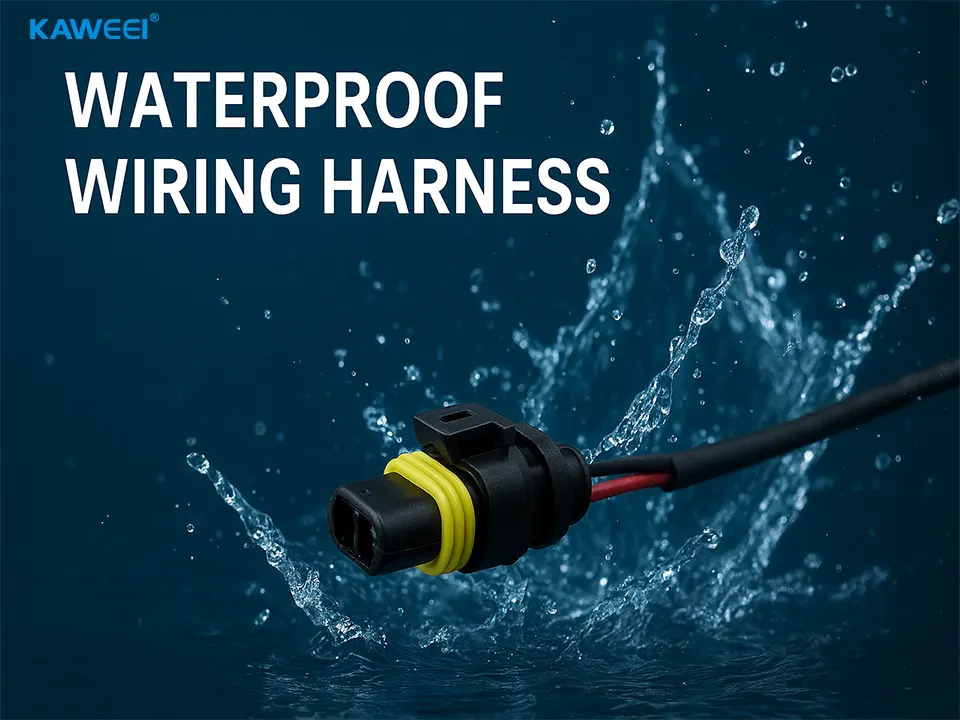Waterproof Cables Guide -Kaweei
In modern industries such as automotive, electrical equipment, machinery manufacturing, outdoor lighting, marine engineering, and communication systems, the Waterproof Wiring Harness plays a vital role in ensuring the safety and reliability of electrical connections.
Unlike standard harnesses, a Waterproof Wiring Harness is specifically designed to prevent moisture, rain, or liquid from entering the connection points. It provides reliable protection against short circuits, corrosion, and electrical failures, especially in harsh or humid environments.
This guide provides comprehensive instructions on the selection, installation, and maintenance of waterproof wiring harnesses to help users ensure optimal performance and longer service life.
What Is a Waterproof Wiring Harness
A Waterproof Wiring Harness is an upgraded version of a standard wiring harness with enhanced sealing and insulation performance. It uses specialized materials and structures to achieve high levels of waterproof protection.

Main features include:
- Excellent waterproof performance – IP67 / IP68 protection rating, effectively preventing rain, dust, or water ingress.
- Corrosion and weather resistance – performs reliably in environments with high humidity, temperature fluctuations, salt spray, or oil exposure.
- Stable electrical connection – made with high-purity copper conductors and high-strength insulation materials for efficient and stable current transmission.
- Customizable design – fully customizable in length, connector type, and sealing structure according to the application environment.
Typical Applications
- Waterproof wiring harnesses are widely used in various industries and outdoor systems, including:
- Automotive and new energy vehicles: engine compartments, chassis, charging systems, and other high-humidity zones.
- Outdoor lighting and security systems: LED streetlights, surveillance cameras, traffic control systems.
- Industrial automation: control systems in damp factories or production lines.
- Marine and offshore applications: onboard electrical systems, navigation, and signal control.
- Power and communication equipment: outdoor cabinets, electrical junction boxes, telecom base stations.
Installation Guidelines
- Check component integrity:Ensure all parts (connectors, seals, plugs, rubber rings, etc.) are intact before installation. Any cracks or aging may reduce waterproof performance.
- Keep connection points clean and dry:Before connecting, make sure the connectors are free of moisture, oil, and dust to ensure a tight seal.
- Connect properly:Align the connectors and insert gently until locked. Avoid forcing or bending the connector pins, which can damage the waterproof seal.
- Secure cable routing:Use cable ties or clips to fix the harness in place, preventing it from being pulled or shaken loose during equipment operation.
Avoid over-bending
- Maintain a bending radius greater than five times the cable diameter to prevent internal conductor breakage or jacket fatigue.
- Match the waterproof level to your environment
- Indoor or slightly damp areas → IP65 harness
- Outdoor or rainy environments → IP67 harness
- Underwater or high-pressure conditions → IP68 harness
Selection Tips for Waterproof Wiring Harnesses
- Choosing the right Waterproof Wiring Harness depends on your working environment and electrical requirements. Consider the following factors:
- Protection level (IP rating) – determine the exposure to water, humidity, or submersion.
- Temperature and environment – silicone materials are suitable for high temperatures, while TPU or XLPE perform better in cold conditions.
- Electrical parameters – ensure the conductor size, current capacity, and connector type meet system requirements.
- Mechanical design – select the appropriate flexibility, shielding, and sheath thickness for your application.
- Customization options – custom harnesses can include waterproof potting, shielding, or special connectors for unique industrial applications.
Looking for custom wiring harnesses? Choose Kaweei! Whether it’s waterproof wiring harnesses or any special requirements, we can create tailor-made solutions for you. Got ideas or needs? Contact us anytime!
Kaweei Custom Waterproof Wiring Harness FAQ
1. What does Kaweei do?
Kaweei is a custom wiring harness manufacturer, specializing in waterproof wiring harnesses.
2. Can I customize waterproof harnesses?
Yes, we can customize length, connectors, materials, and waterproof level to fit your needs.
3. What waterproof levels are available?
We provide IP65, IP67, and IP68 waterproof harnesses for various applications.
4. Which industries use Kaweei harnesses?
Automotive, industrial machinery, marine systems, outdoor lighting, and electronics.
5. How can I get a quote?
Send us your drawings, samples, or specifications, and we’ll provide a quote quickly.


